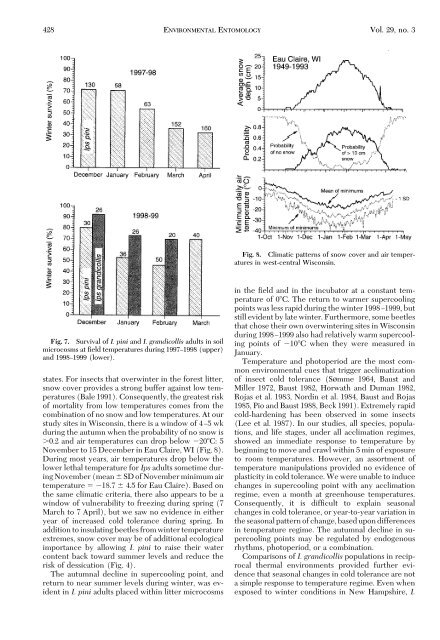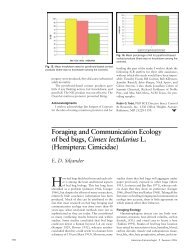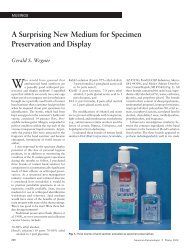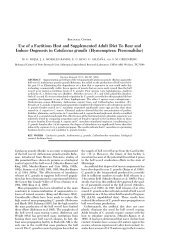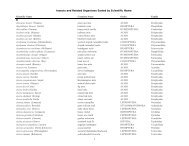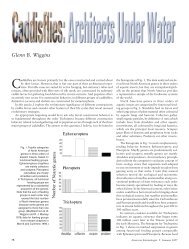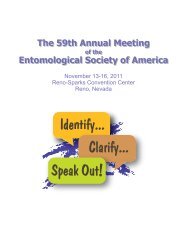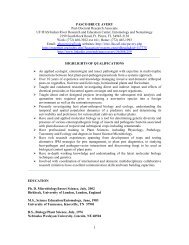Cold Tolerance of Four Species of Bark Beetle (Coleoptera ...
Cold Tolerance of Four Species of Bark Beetle (Coleoptera ...
Cold Tolerance of Four Species of Bark Beetle (Coleoptera ...
You also want an ePaper? Increase the reach of your titles
YUMPU automatically turns print PDFs into web optimized ePapers that Google loves.
428 ENVIRONMENTAL ENTOMOLOGY Vol. 29, no. 3<br />
Fig. 7. Survival <strong>of</strong> I. pini and I. grandicollis adults in soil<br />
microcosms at Þeld temperatures during 1997Ð1998 (upper)<br />
and 1998Ð1999 (lower).<br />
states. For insects that overwinter in the forest litter,<br />
snow cover provides a strong buffer against low temperatures<br />
(Bale 1991). Consequently, the greatest risk<br />
<strong>of</strong> mortality from low temperatures comes from the<br />
combination <strong>of</strong> no snow and low temperatures. At our<br />
study sites in Wisconsin, there is a window <strong>of</strong> 4Ð5 wk<br />
during the autumn when the probability <strong>of</strong> no snow is<br />
0.2 and air temperatures can drop below 20C: 5<br />
November to 15 December in Eau Claire, WI (Fig. 8).<br />
During most years, air temperatures drop below the<br />
lower lethal temperature for Ips adults sometime during<br />
November (mean SD <strong>of</strong> November minimum air<br />
temperature 18.7 4.5 for Eau Claire). Based on<br />
the same climatic criteria, there also appears to be a<br />
window <strong>of</strong> vulnerability to freezing during spring (7<br />
March to 7 April), but we saw no evidence in either<br />
year <strong>of</strong> increased cold tolerance during spring. In<br />
addition to insulating beetles from winter temperature<br />
extremes, snow cover may be <strong>of</strong> additional ecological<br />
importance by allowing I. pini to raise their water<br />
content back toward summer levels and reduce the<br />
risk <strong>of</strong> dessication (Fig. 4).<br />
The autumnal decline in supercooling point, and<br />
return to near summer levels during winter, was evident<br />
in I. pini adults placed within litter microcosms<br />
Fig. 8. Climatic patterns <strong>of</strong> snow cover and air temperatures<br />
in west-central Wisconsin.<br />
in the Þeld and in the incubator at a constant temperature<br />
<strong>of</strong> 0C. The return to warmer supercooling<br />
points was less rapid during the winter 1998Ð1999, but<br />
still evident by late winter. Furthermore, some beetles<br />
that chose their own overwintering sites in Wisconsin<br />
during 1998Ð1999 also had relatively warm supercooling<br />
points <strong>of</strong> 10C when they were measured in<br />
January.<br />
Temperature and photoperiod are the most common<br />
environmental cues that trigger acclimatization<br />
<strong>of</strong> insect cold tolerance (Sømme 1964, Baust and<br />
Miller 1972, Baust 1982, Horwath and Duman 1982,<br />
Rojas et al. 1983, Nordin et al. 1984, Baust and Rojas<br />
1985, Pio and Baust 1988, Beck 1991). Extremely rapid<br />
cold-hardening has been observed in some insects<br />
(Lee et al. 1987). In our studies, all species, populations,<br />
and life stages, under all acclimation regimes,<br />
showed an immediate response to temperature by<br />
beginning to move and crawl within 5 min <strong>of</strong> exposure<br />
to room temperatures. However, an assortment <strong>of</strong><br />
temperature manipulations provided no evidence <strong>of</strong><br />
plasticity in cold tolerance. We were unable to induce<br />
changes in supercooling point with any acclimation<br />
regime, even a month at greenhouse temperatures.<br />
Consequently, it is difÞcult to explain seasonal<br />
changes in cold tolerance, or year-to-year variation in<br />
the seasonal pattern <strong>of</strong> change, based upon differences<br />
in temperature regime. The autumnal decline in supercooling<br />
points may be regulated by endogenous<br />
rhythms, photoperiod, or a combination.<br />
Comparisons <strong>of</strong> I. grandicollis populations in reciprocal<br />
thermal environments provided further evidence<br />
that seasonal changes in cold tolerance are not<br />
a simple response to temperature regime. Even when<br />
exposed to winter conditions in New Hampshire, I.


